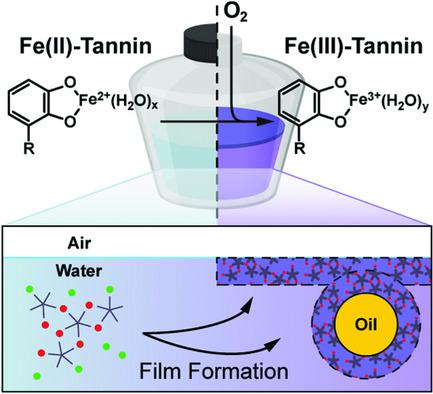当前位置:
X-MOL 学术
›
Adv. Mater.
›
论文详情
Our official English website, www.x-mol.net, welcomes your feedback! (Note: you will need to create a separate account there.)
Iron Gall Ink Revisited: In Situ Oxidation of Fe(II)–Tannin Complex for Fluidic‐Interface Engineering
Advanced Materials ( IF 29.4 ) Pub Date : 2018-10-09 , DOI: 10.1002/adma.201805091 Hojae Lee 1 , Won Il Kim 1 , Wongu Youn 1 , Taegyun Park 1 , Sangmin Lee 2 , Taek-Soo Kim 2 , João F. Mano 3 , Insung S. Choi 1
Advanced Materials ( IF 29.4 ) Pub Date : 2018-10-09 , DOI: 10.1002/adma.201805091 Hojae Lee 1 , Won Il Kim 1 , Wongu Youn 1 , Taegyun Park 1 , Sangmin Lee 2 , Taek-Soo Kim 2 , João F. Mano 3 , Insung S. Choi 1
Affiliation

|
The ancient wisdom found in iron gall ink guides this work to a simple but advanced solution to the molecular engineering of fluidic interfaces. The Fe(II)–tannin coordination complex, a precursor of the iron gall ink, transforms into interface‐active Fe(III)–tannin species, by oxygen molecules, which form a self‐assembled layer at the fluidic interface spontaneously but still controllably. Kinetic studies show that the oxidation rate is directed by the counteranion of Fe(II) precursor salts, and FeCl2 is found to be more effective than FeSO4—an ingredient of iron gall ink—in the interfacial‐film fabrication. The optimized protocol leads to the formation of micrometer‐thick, free‐standing films at the air–water interface by continuously generating Fe(III)–tannic acid complexes in situ. The durable films formed are transferable, self‐healable, pliable, and postfunctionalizable, and are hardened further by transfer to the basic buffer. This O2‐instructed film formation can be applied to other fluidic interfaces that have high O2 level, demonstrated by emulsion stabilization and concurrent capsule formation at the oil–water interface with no aid of surfactants. The system, inspired by the iron gall ink, provides new vistas on interface engineering and related materials science.
中文翻译:

再谈铁胆油墨:用于流体界面工程的Fe(II)-单宁络合物的原位氧化
铁胆油墨中发现的古老智慧将这项工作引导到了一种简单而先进的解决方案,用于流体界面的分子工程。Fe(II)-单宁配位络合物(铁胆油墨的前体)通过氧分子转变为界面活性的Fe(III)-单宁物种,它们在流体界面上自发形成自组装层,但仍然可控。动力学研究表明,氧化速率是由Fe(II)前体盐的抗衡离子控制的,并且发现FeCl 2比FeSO 4更有效(铁胆油墨的一种成分)在界面膜制造中。优化的方案通过连续不断地原位生成Fe(III)-鞣酸络合物,导致在空气-水界面处形成微米厚的独立膜。形成的耐用膜具有可转移性,自修复性,柔韧性和后功能性,并且可以通过转移到基本缓冲液中进一步硬化。这种由O 2指示的成膜作用可以应用于其他具有高O 2含量的流体界面,这可以通过乳液稳定化和同时在油水界面上形成胶囊而无需使用表面活性剂来证明。该系统受铁胆油墨的启发,为界面工程和相关材料科学提供了新的视野。
更新日期:2018-10-09
中文翻译:

再谈铁胆油墨:用于流体界面工程的Fe(II)-单宁络合物的原位氧化
铁胆油墨中发现的古老智慧将这项工作引导到了一种简单而先进的解决方案,用于流体界面的分子工程。Fe(II)-单宁配位络合物(铁胆油墨的前体)通过氧分子转变为界面活性的Fe(III)-单宁物种,它们在流体界面上自发形成自组装层,但仍然可控。动力学研究表明,氧化速率是由Fe(II)前体盐的抗衡离子控制的,并且发现FeCl 2比FeSO 4更有效(铁胆油墨的一种成分)在界面膜制造中。优化的方案通过连续不断地原位生成Fe(III)-鞣酸络合物,导致在空气-水界面处形成微米厚的独立膜。形成的耐用膜具有可转移性,自修复性,柔韧性和后功能性,并且可以通过转移到基本缓冲液中进一步硬化。这种由O 2指示的成膜作用可以应用于其他具有高O 2含量的流体界面,这可以通过乳液稳定化和同时在油水界面上形成胶囊而无需使用表面活性剂来证明。该系统受铁胆油墨的启发,为界面工程和相关材料科学提供了新的视野。



























 京公网安备 11010802027423号
京公网安备 11010802027423号